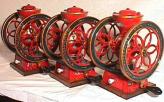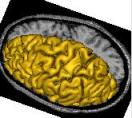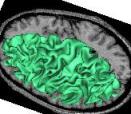







Trigger all segmentation tools for T1-weighted data
This pipeline allows to compute:Before running a pipeline, you have to fill in image orientation parameters in the first step, or independently use use the Prepare Subject for Anatomical Pipeline process. Be careful that the default recognition method in BrainVISA 4.1 has changed to SPAM recognition with global+local registration, if the corresponding models have been installed.
- either all of what can be done;
- or a subset oriented towards a specific application:
- Spherical meshes of the cortex (inflation, Cortical Surface Mapping, "primal sketch" of mean curvature, MEG/EEG inverse problem...)
- Hemisphere meshes (visualisation, mapping of activations...)
- Cortical fold graphs (structural morphometry, constraints for spatial normalisation, surgical planing...).
A pipeline normally deals with both hemispheres, but can be askes to process only one. Processing steps are executed in the following order (except when some results have already been validated/locked or unchecked in the graphical interface):
- Ensure image orientation and reorient it if needed (Prepare Subject for Anatomical Pipeline)
- Computation of a brain mask (Brain Mask Segmentation);
- Computation of a mask for each hemisphere (Split Brain Mask).
- A grey/white classification of each hemisphere to perform "Voxel Based Morphometry" (Grey White Interface) and spherical triangulation of cortical hemispheres (Ana Get Spherical Cortical Surface);
- Triangulation of the external interface of the cortex of one or two hemispheres (Ana Get Opened Hemi Surface);
- Computation of a graph representing the cortical fold topography (Cortical Fold Graph);
- Possibly, automatic identification of the cortical sulci (Automatic Sulci Recognition), located in the "sulci" toolbox.
A number of these steps allow to choose between an older version of the algorithm and a new one (not always completely ready, be careful!). The default settings correspond to the alternative we consider to be the most robust or the most performant, but a different choice may achieve better results on some images.
With some practice, you may play iteratively with the pipelines. For instance, if you have trigerred a "sub-pipeline" only, you may ask for more without having to recompute the whole stuff. For that purpose, lock the first results using Brainvisa validation tools.
The different active pipelines are the following (you may find other ones elsewhere when the input is not the raw T1-weighted MR scan):













Efficient use of the pipeline:
If you want to process a large population of brains, we advise the following strategy:
- Select a few representative brains, and tune the parameters in order to achieve acceptable results. Several levels of tuning can be tried:
If you are not unlucky, you should find a good solution with the two highest levels only, otherwise it may be interesting to derive your own pipeline using SHFJ low-level bricks, Vip library and maybe your own local tools. This is what is done for example in Marseille fMRI site because of the 3T large bias field: http://marspack.free.fr/.
- The two choices on grey/white contrast and bias field types.
- The alternative computations of the brain mask and voronoi diagrams (hemispheres).
Ana Brain Mask from T1 MRI Correction
Ana Split Brain from Brain Mask Correction- The various parameters of the low level tools in components and components04.
- The numerous parameters of the commanlines of Vip library (VipSomething).
- After the tuning stage, we suggest to perform the processing in three stages:
- From raw MR data to the brain mask: This is usually performed by the treatment Ana Brain Mask from T1 MRI, which can be iterated on all your brains. Then check the results one by one and trigger some of the alternatives of Ana Brain Mask from T1 MRI Correction for the brains which require some corrections (you could even perform some manual corrections with Anatomist drawing's capacities: Label volume editor).
- From the brain mask to the hemisphere mask: This is usually performed by the treatment Ana Split Brain from Brain Mask, which can be iterated on all your brains. Then check the results one by one and trigger some of the alternatives of Ana Split Brain from Brain Mask Correction for the brains which require some corrections (you could even perform some manual corrections with Anatomist drawing's capacities: Label volume editor; you can use a shortcut to this treatment through a dedicated icon in brainVISA interface).
- Any further processing (meshes, graphs, etc.): You have first to lock the results of the two previous stages, for them not to be superseded by the general pipeline treatment. Use: Ana Validate All. Then you can iterate the pipeline you like and go to sleep.













mri: Raw T1 MRI ( input )
mri_corrected: T1 MRI Bias Corrected ( output )
perform_normalization: Boolean ( input )
Normalised: Choice ( optional, input )
Anterior_Commissure: Point3D ( optional, input )
Posterior_Commissure: Point3D ( optional, input )
Interhemispheric_Point: Point3D ( optional, input )
Left_Hemisphere_Point: Point3D ( optional, input )
Toolbox : Morphologist
User level : 2
Identifier :
t1pipeline07File name :
brainvisa/toolboxes/morphologist/processes/segmentationpipeline/older_pipelines/t1pipeline07.pySupported file formats :
mri :gz compressed NIFTI-1 image, Aperio svs, BMP image, DICOM image, Directory, ECAT i image, ECAT v image, FDF image, FreesurferMGH, FreesurferMGZ, GIF image, GIS image, Hamamatsu ndpi, Hamamatsu vms, Hamamatsu vmu, JPEG image, Leica scn, MINC image, NIFTI-1 image, PBM image, PGM image, PNG image, PPM image, SPM image, Sakura svslide, TIFF image, TIFF image, TIFF(.tif) image, TIFF(.tif) image, VIDA image, Ventana bif, XBM image, XPM image, Zeiss czi, gz compressed MINC image, gz compressed NIFTI-1 imagemri_corrected :gz compressed NIFTI-1 image, BMP image, DICOM image, Directory, ECAT i image, ECAT v image, FDF image, GIF image, GIS image, JPEG image, MINC image, NIFTI-1 image, PBM image, PGM image, PNG image, PPM image, SPM image, TIFF image, TIFF(.tif) image, VIDA image, XBM image, XPM image, gz compressed MINC image, gz compressed NIFTI-1 image